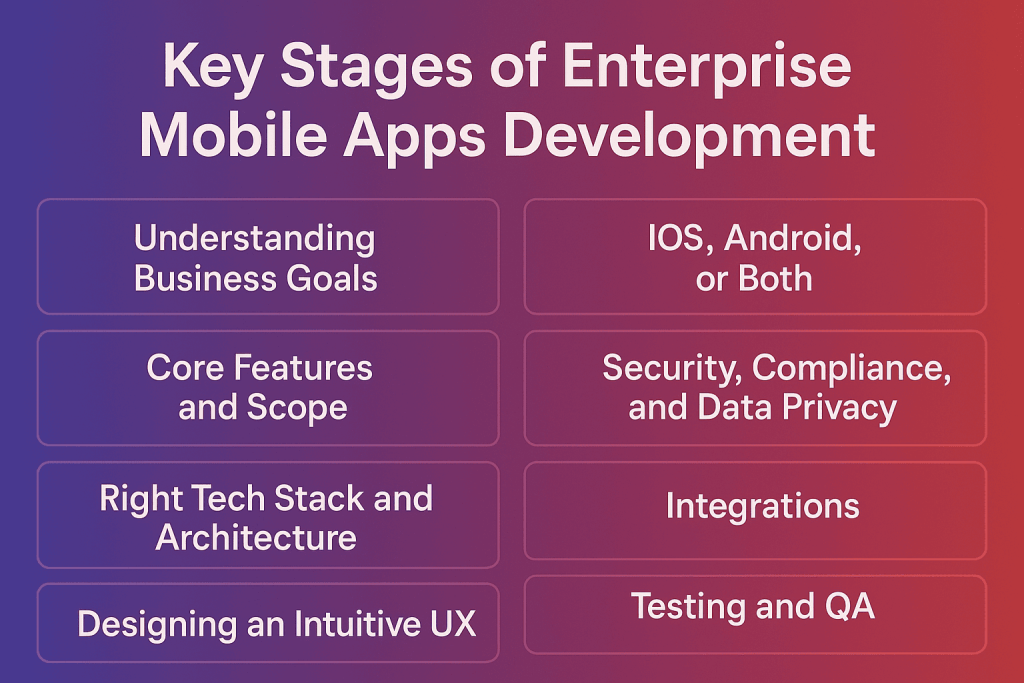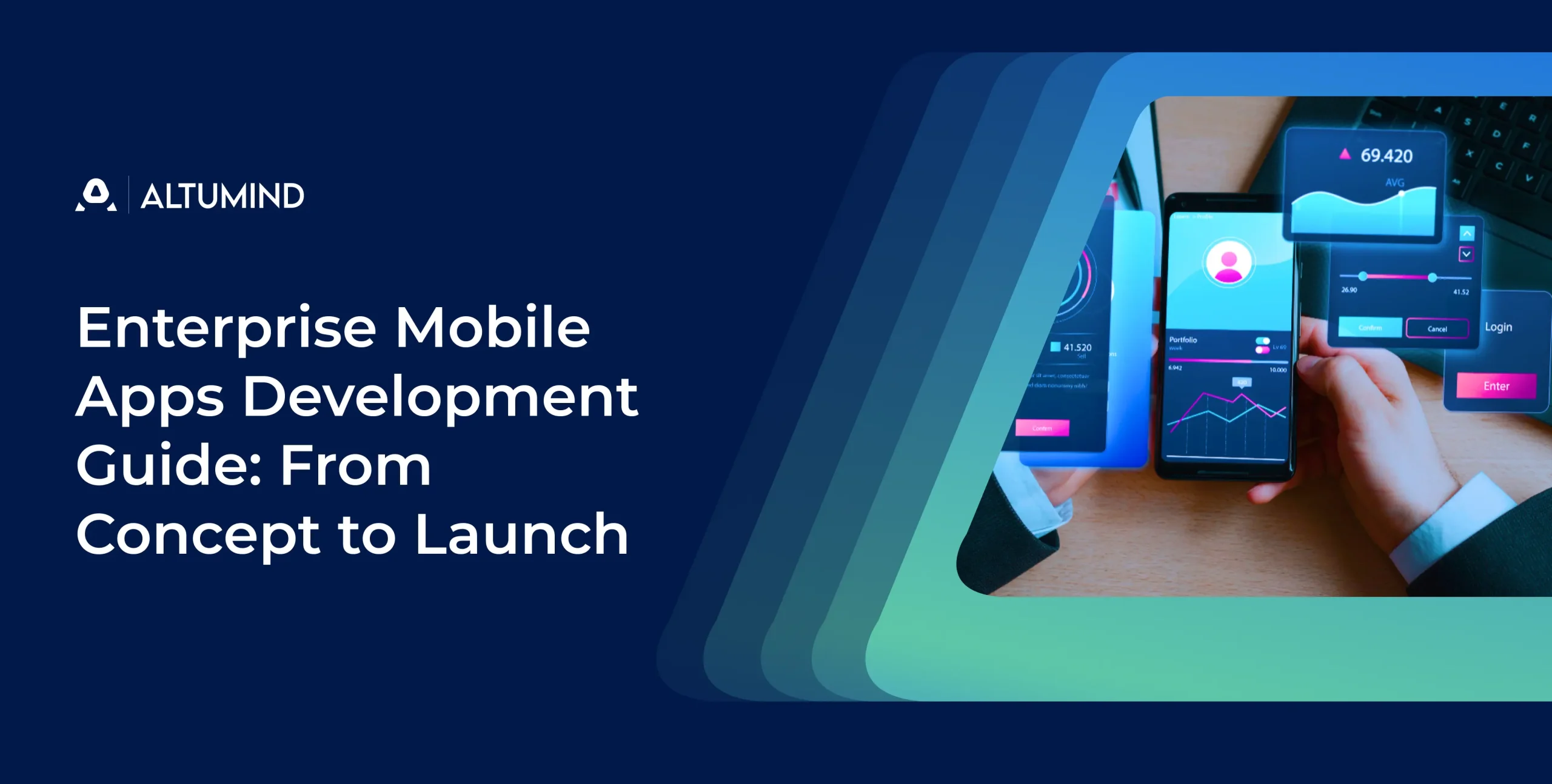In today’s corporate digital landscape, enterprise mobile apps development has become a cornerstone of digital transformation. These apps do more than streamline customer experiences, they also improve internal operations, enhance productivity, and serve as strategic assets for modern businesses.
However, turning an idea into a fully functional, user-friendly, and high-performing Enterprise Applications for Business demands more than just inspiration. It requires careful planning, the right technology stack, and flawless execution.
This guide walks you through the end-to-end enterprise mobile apps development journey, ensuring your solution is built to be resilient, scalable, and future-ready.
Key Stages of Enterprise Mobile Apps Development

1. Understanding Business Goals:
Clarify the why behind the mobile app and outline the clear value proposition and KPIs of what you hope to achieve. Align leadership and teams through stakeholder interviews and discovery workshops.
Map user personas, permission levels, and current workflows to create a detailed roadmap. Identify pain points and inefficiencies using flowcharts or whiteboarding to visualize the current and future state.
While some off-the-shelf tools offer basic capabilities, they often lack the flexibility and integration power required for enterprise ecosystems. That’s why custom-built solutions from partners like Altumind can deliver real strategic advantage.
2. Core Features and Scope:
Start by identifying key features aligned with business goals like dashboards, file uploads, offline access, and notifications using a feature matrix. Prioritize them using frameworks like MoSCoW or RICE, and validate with stakeholders.
Define the MVP by focusing on essential workflows and user roles. Create a clear feature list (functional and non-functional) with notes on complexity, security, dependencies, and performance.
Outline out-of-scope items to avoid scope creep. Use a Permission Matrix to map user roles and access levels, and visualize feature connections using tools like Whimsical or Lucidchart.
Finally, estimate costs, timeline, team size, and budget based on the finalized scope.
3. iOS, Android, or Both:
Start by analyzing device usage using IT reports, MDM tools, or employee surveys. If your organization uses BYOD (Bring Your Own Device), supporting both iOS and Android is usually essential.
Assess platform-specific features like NFC, camera APIs, biometric authentication, and background sync limits. Create a compliance checklist for regulations like GDPR and SOC 2. Note, that iOS offers stricter sandboxing, while Android provides more flexibility but requires tighter MDM controls.
To streamline development, consider cross-platform frameworks like Flutter or React Native for faster delivery and lower costs. Evaluate distribution options such as Microsoft Intune or VMware Workspace ONE.
Use a Platform Decision Matrix to compare user base, cost, features, and security between platforms. Choosing the right OS strategy is critical – Altumind helps enterprises map mobile platforms to business needs without guesswork.
4. Right Tech Stack and Architecture:
Choosing the right tech stack and architecture is key to building scalable, high-performance, and secure enterprise mobile apps.
- Frontend: Use native frameworks like SwiftUI, Kotlin, Jetpack Compose, or cross-platform tools like Flutter and React Native.
- Backend: Go with robust frameworks like Node.js, Spring Boot, or Django. Use REST, GraphQL, or gRPC for APIs. Consider architectures like monolithic, microservices, or serverless. Incorporate proper authentication, choose between stateless/stateful design, and use message queues like Kafka or WebSockets for real-time data.
- Database: Select SQL (PostgreSQL, MySQL) or NoSQL (MongoDB, Firebase) based on your data structure and scaling needs. Ensure secure data storage and real-time synchronization.
- DevOps & CI/CD: Automate development and deployment with tools like Gradle, Fastlane, Jenkins, Docker, or GitHub Actions. Use cloud services (AWS, Azure, GCP), enable auto-scaling or serverless compute, and apply caching (Redis, Memcached) and load balancing (NGINX, Cloud Load Balancer) strategies.
Choose the right cloud provider AWS, Azure, GCP, etc., the right scalability option like auto-scaling or serverless compute, multi-tenancy support, the right caching layers Redis or Memcached), and the right load balancing strategies between Cloud Load Balancer or NGINX.
5. Security, Compliance, and Data Privacy:
Design a zero-trust architecture using models like STRIDE and DREAD, backed by defined security SLAs, audit logging, and incident response plans. Identify and secure vulnerable endpoints, and ensure app-store guideline compliance.
- Data Protection: Use HTTPS with TLS 1.2/1.3 for secure data transmission and AES-256 for encrypting data at rest. Store credentials securely using iOS Keychain or Android Keystore.
- Authentication & Access Control: Enforce MFA, OAuth 2.0 or OpenID Connect, and biometric login. Use RBAC to manage permissions and implement device-level checks like jailbreak detection.
- Compliance: Meet global standards like NIST, CIS, SOC 2, ISO 27001, and regional regulations such as GDPR (EU) and CCPA (California), plus any industry-specific policies.
6. Designing an Intuitive UX:
Start with low-fidelity wireframes for core screens like dashboards, forms, and navigation menus, based on key user scenarios. Use median user personas to map typical task flows and journeys.
Ensure accessible, intuitive navigation with thoughtful use of menus, inputs, gestures, and micro-interactions. Follow ADA and WCAG guidelines for contrast, font size, and readability.
Create a component library with reusable UI elements aligned to brand colors, fonts, and icons. Build high-fidelity mockups and an interactive prototype to walk stakeholders through the design.
Conduct usability testing, gather feedback, and iterate. Finalize assets and specs for handoff using tools like Zeplin or Figma Inspect, ensuring clarity in spacing, fonts, and color usage.
7. Integrations:
Ensure your app seamlessly connects with both internal systems and external services.
- Internal Integrations: Connect to enterprise systems like SAP, Salesforce, Oracle, LDAP/SSO, Active Directory, and data warehouses like Snowflake or Redshift. Include collaboration tools (e.g., Teams), HR platforms (e.g., Workday), file systems, and legacy databases as needed.
- External Integrations:
Integrate with payment gateways (Stripe, Razorpay, PayPal), notification services (Firebase, OneSignal), and messaging APIs (Twilio, SendGrid, WhatsApp). Support social logins and marketing via Facebook and LinkedIn, and eCommerce/logistics platforms like Shopify and FedEx. Use Google Maps for location-based features.
8. Team Structure and Development Methodology:
While some businesses experiment with in-house or hybrid teams, partnering with a digital transformation firm like Altumind ensures strategic oversight, scalable talent, and deep domain knowledge which are some of the key advantages when stakes are high.
A small app would need 4-6 resources, but large-scale ones may require 20+. Adopt agile methodology, Scrum, or Kanban, based on team size and delivery with sprint planning, daily stand-ups, and velocity tracking. Have feedback loops, alignment workshops, and demos. Embed code review practices and manage tasks through Jira, Slack, and Teams.
Common Roles: Scrum masters, developers (frontend & backend), DevOps engineers, UX designers, security specialists, and Quality analysts.
9. Testing and QA:
In enterprise mobile apps development, rigorous testing and QA are essential to ensure stability across varied devices, operating systems, and enterprise use cases. Define test objectives, test case design, KPIs, and environments. Perform automated UI testing using Appium, Selenium, or Detox, and API testing through Postman or Rest Assured.
Further, conduct unit, component & integration, exploratory, system, sanity, and regression testing. Perform UI/UX validation, check cross-platform consistency, and evaluate user journeys. Don’t forget load & stress testing, load time analysis, and response time benchmarking to review performance. Conduct Dynamic analysis (DAST), Static code analysis (SAST), data leakage, and authentication testing as part of security checks. Further, do network, DPI (Screen resolution), and real users beta testing.
10. Deployment and Enterprise Distribution:
After completing the final testing and QA, roll out the app in a big-bang or phased-out manner via a company portal or intranet. Use either Apple’s Enterprise Developer Program. For Android, Google Managed Play, or Mobile Device Management (MDM) solutions such as Intune, AirWatch, or Jamf, or custom APK links.
Stick to the deployment timelines and go-live windows. Also, outline rollback strategies in case of failure. Track app usage, crashes, and performance metrics through Firebase Performance or New Relic. Work on the FAQs, guides, bug reporting process, and helpdesk support. Furthermore, push regular updates, maintain versions, patch up security, and collect in-app feedback.
Wrapping Up: Enterprise App Solutions
Enterprise app solutions are cornerstones of business efficiency and collaboration. Stemming from that thought process, many organizations gravitate towards enterprise mobile apps development to streamline workflows and revolutionize their operational prowess. A full-fledged, scalable enterprise mobile app can future-proof their business towards true growth and sustained profits.
On average, companies are seeing an ROI of 35% when investing in enterprise mobile apps. – Adobe
Ready to bring your enterprise mobile apps to life? Altumind builds tailored, scalable mobile solutions that seamlessly integrate with your digital ecosystem and drive real business value. Our enterprise app solutions aim to unlock trapped value for higher innovation and efficiency. Contact Altumind to develop a cutting-edge enterprise app that meets industry standards and business needs.


